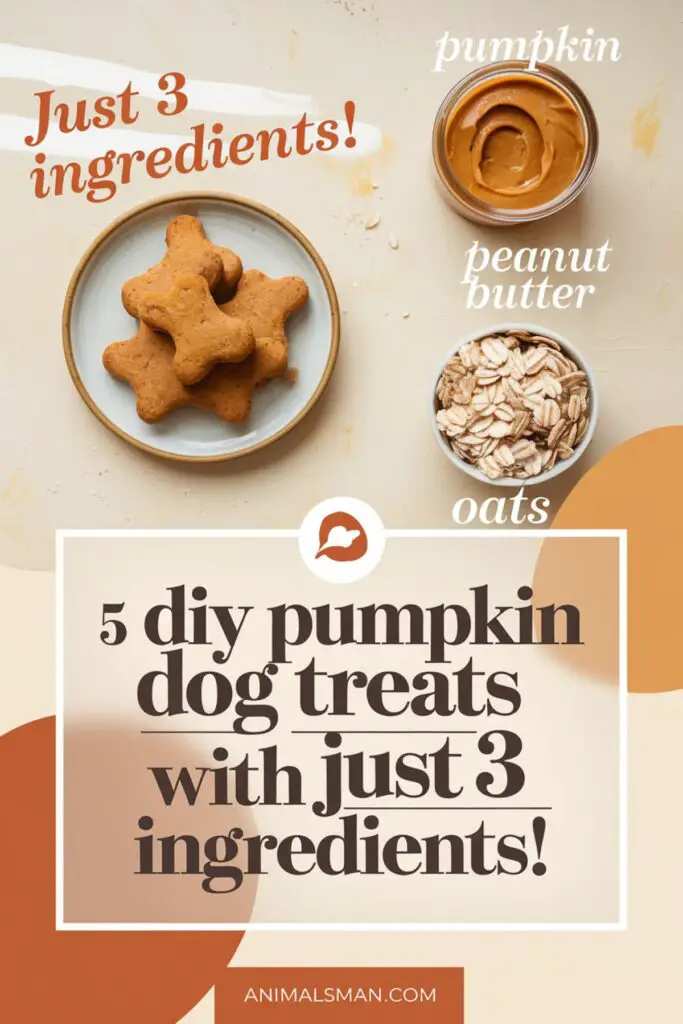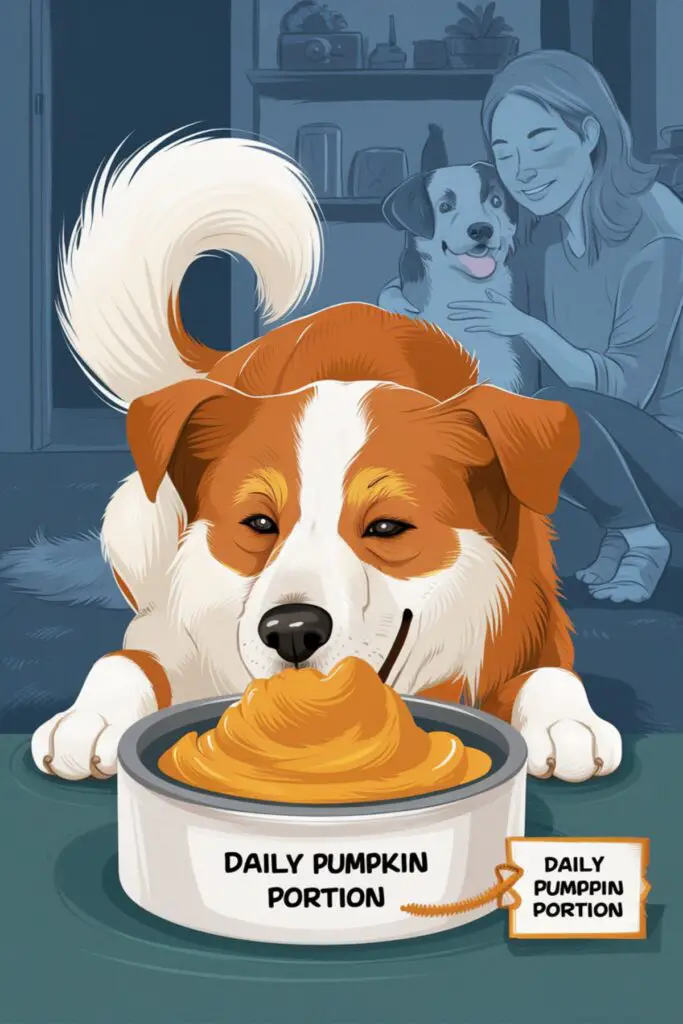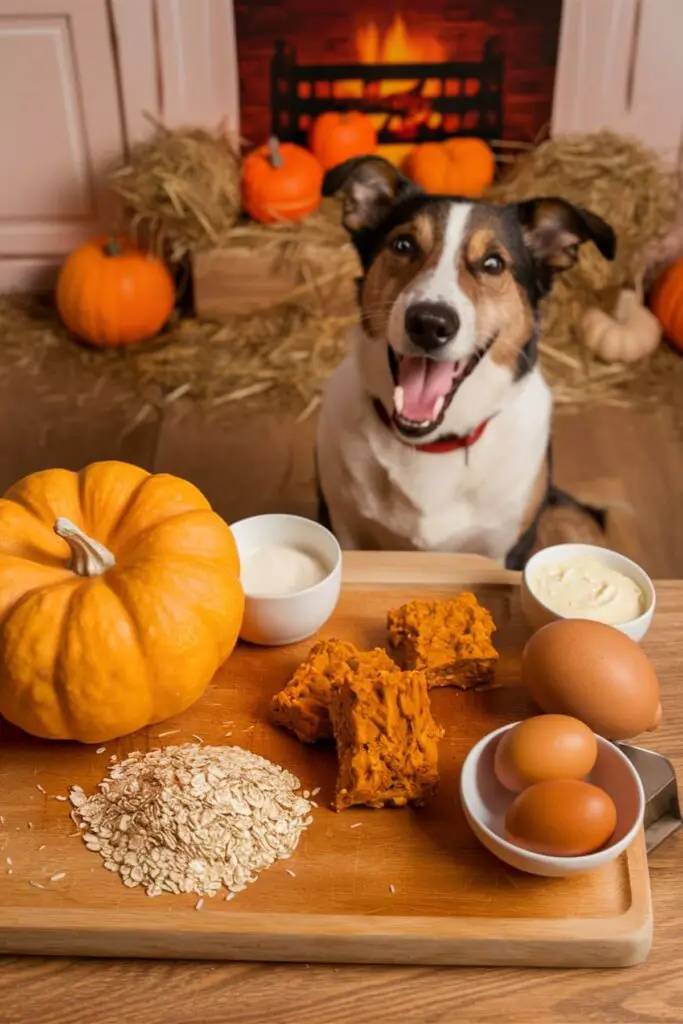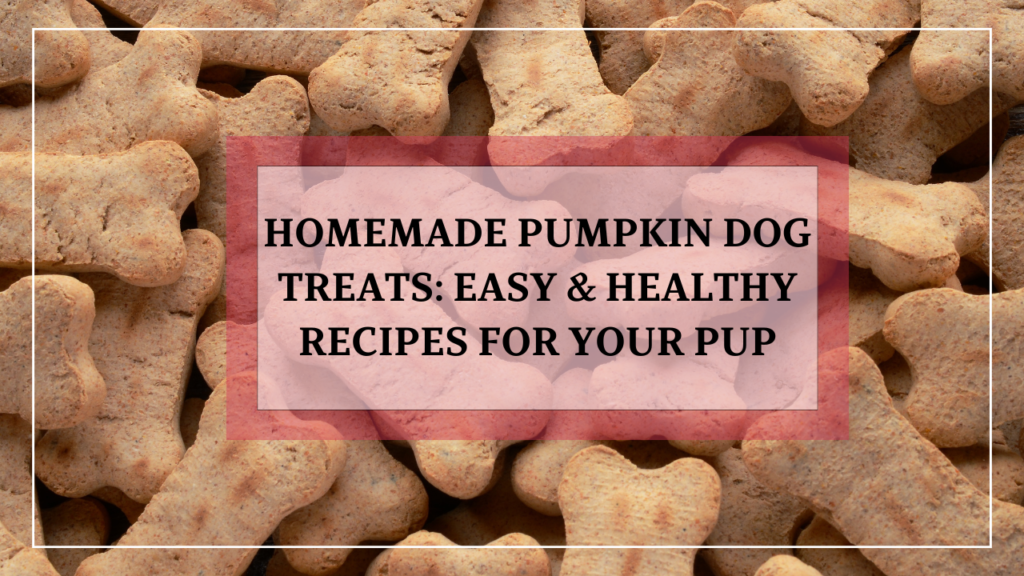Pumpkin is often considered a superfood for dogs. Its versatility and nutrient-rich profile make it a great addition to homemade dog treats. Whether you’re a seasoned pet owner or a first-time dog parent, understanding why pumpkin is good for dogs is the first step to creating delicious and healthy treats for your furry friend.
Nutritional Benefits of Pumpkin for Dogs

- Fiber: Pumpkin is high in fiber, which is excellent for maintaining a healthy digestive system. For dogs that struggle with constipation or diarrhea, the fiber in pumpkin can help regulate their bowel movements.
- Vitamins: Rich in Vitamin A, C, and E, pumpkin supports healthy skin, a strong immune system, and proper eye health in dogs.
- Potassium: This mineral is crucial for heart health and helps with muscle function and maintaining a balanced fluid level in your dog’s body.
- Low-Calorie: With fewer calories than many commercial treats, pumpkin is an ideal treat for dogs that need to maintain or lose weight.
Pumpkin is packed with essential nutrients that can benefit your dog’s health in numerous ways. Here’s a breakdown of the key nutrients in pumpkin:
In addition to these benefits, pumpkin is also hydrating, containing about 90% water. This is a great perk, especially during warmer months, as it helps keep your dog hydrated while enjoying a tasty snack.
Can All Dogs Eat Pumpkin?

While pumpkin is generally safe for most dogs, there are some exceptions. Dogs with food allergies or sensitive stomachs may need a bit more caution. It’s always a good idea to start with small amounts and observe how your dog reacts. Some dogs may show signs of an upset stomach if they consume too much pumpkin.
For most dogs, pumpkin can be included in their diet as a regular treat. However, it’s essential to ensure that they are eating the correct portions based on their size. Below is a quick guide on pumpkin serving sizes for dogs:
| Dog Size | Recommended Daily Pumpkin Portion |
| Small (10-20 lbs) | 1 to 2 teaspoons |
| Medium (20-50 lbs) | 1 to 2 tablespoons |
| Large (50+ lbs) | 2 to 4 tablespoons |
Note: Always consult your veterinarian if you’re unsure whether pumpkin is suitable for your dog or if you want to know the exact serving size based on their specific needs.
Pumpkin Dog Treat Recipes: Nutritious Recipes for Your Pup

Incorporating pumpkin into dog treats is an excellent way to provide your furry friend with a healthy, nutrient-packed snack. But why stop at just pumpkin? By adding ingredients like sweet potatoes, chicken, or bananas, you can create exciting flavor variations that will keep your dog coming back for more. Here are three in-depth recipes that combine pumpkin with other healthy ingredients to boost nutrition and add variety to your dog’s treat jar.
Pumpkin and Sweet Potato Dog Treats Recipe

Sweet potatoes and pumpkin are a perfect pair, delivering a nutritious and delicious treat that dogs love. Rich in fiber, antioxidants, and essential vitamins, these treats are not only tasty but also beneficial for your dog’s digestive health. The natural sweetness of sweet potatoes enhances the flavor, making this recipe especially appealing to picky eaters.
Ingredients:
- 1 cup of pumpkin puree (100% pure, unsweetened)
- 1 medium sweet potato (cooked and mashed)
- 2 ½ cups of whole wheat flour (or oat flour for a grain-free option)
- 1 egg
- ½ teaspoon of ground cinnamon (optional, for added flavor)
Step-by-Step Instructions:
- Prepare the Sweet Potato: Peel and boil the sweet potato for about 15 minutes until tender. Mash it until smooth and set aside.
- Mix Wet Ingredients: In a large mixing bowl, combine the pumpkin puree, mashed sweet potato, and egg. Stir until smooth and well incorporated.
- Add the Flour: Gradually mix in the flour. Stir continuously until the dough forms. If the dough is sticky, add flour little by little until it’s workable.
- Shape the Dough: Roll out the dough to about ¼ inch thickness on a floured surface. Use cookie cutters or a knife to shape the dough into fun shapes or squares.
- Bake the Treats: Arrange the shaped dough on a parchment-lined baking sheet. Bake at 350°F (175°C) for 25-30 minutes, or until golden brown and firm to the touch.
- Cool and Serve: Allow the treats to cool completely before serving to your dog.
Cooking Time:
- Prep time: 15 minutes
- Cook time: 25-30 minutes
- Total time: 40-45 minutes
Serving Size:
This recipe yields approximately 20-24 treats, depending on the size of the shapes.
Storage Instructions:
Store in an airtight container at room temperature for up to 1 week. For long-term storage, freeze the treats for up to 3 months.
Nutritional Information:
- Calories: Approx. 45 calories per treat (based on size)
- Key Benefits: High in fiber, vitamin A, and potassium, which supports eye health, immune function, and digestion.
Tips and Variations:
- Variation 1: Try adding a tablespoon of peanut butter to the dough for added protein and flavor.
- Variation 2: Substitute the whole wheat flour with oat flour for a gluten-free option.
Pumpkin and Chicken Dog Treats Recipe

If your dog enjoys savory treats, this pumpkin and chicken recipe is the perfect combination. Packed with lean protein from the chicken and the beneficial nutrients in pumpkin, these treats are great for muscle maintenance and overall health. Plus, they are a filling and tasty option that active dogs will love.
Ingredients:
- 1 cup of pumpkin puree
- 1 cup of cooked, shredded chicken (skinless, boneless, no seasoning)
- 2 ½ cups of whole wheat flour (or a grain-free alternative like coconut flour)
- 1 egg
- 2 tablespoons of chicken broth (low sodium)
Step-by-Step Instructions:
- Prepare the Chicken: Cook the chicken breast thoroughly (boil or bake) and shred it into small, bite-sized pieces. Let it cool before use.
- Mix the Wet Ingredients: In a large mixing bowl, combine the pumpkin puree, shredded chicken, egg, and chicken broth. Stir until everything is evenly incorporated.
- Add the Flour: Gradually mix in the flour. If the dough becomes too thick, knead it by hand to ensure it’s well combined.
- Shape the Dough: Roll the dough out on a floured surface to about ¼ inch thickness. Use cookie cutters or a knife to cut out your desired shapes.
- Bake the Treats: Place the treats on a parchment-lined baking sheet and bake at 350°F (175°C) for 20-25 minutes, or until they’re firm and golden brown.
- Cool and Serve: Allow the treats to cool completely before serving them to your dog.
Cooking Time:
- Prep time: 10 minutes
- Cook time: 20-25 minutes
- Total time: 30-35 minutes
Serving Size:
This recipe yields around 15-20 treats, depending on the size of the shapes.
Storage Instructions:
Store in the refrigerator for up to 5 days. These treats can also be frozen for up to 3 months.
Nutritional Information:
- Calories: Approx. 50 calories per treat
- Key Benefits: High in protein and low in fat, these treats are perfect for supporting muscle development and overall health.
Tips and Variations:
- Variation 1: You can swap the chicken broth for vegetable broth to make it vegetarian-friendly.
- Variation 2: Add a teaspoon of turmeric for its anti-inflammatory benefits.
Pumpkin and Banana Dog Treats Recipe

Bananas and pumpkin make a naturally sweet and nutritious combo that dogs can’t resist. This recipe is ideal for dogs who enjoy fruity treats and need a healthy, low-sugar option. With the added potassium from the bananas and fiber from the pumpkin, these treats support digestion, heart health, and overall well-being.
Ingredients:
- 1 cup of pumpkin puree
- 1 ripe banana (mashed)
- 2 ½ cups of whole wheat flour (or any flour of your choice)
- 1 egg
- ½ teaspoon of ground flaxseed (optional, for added omega-3 fatty acids)
Step-by-Step Instructions:
- Mash the Banana: In a large bowl, mash the ripe banana until smooth.
- Combine Wet Ingredients: Add the pumpkin puree and egg to the mashed banana. Stir well until the mixture is fully combined.
- Add the Flour and Flaxseed: Gradually add the flour and ground flaxseed (if using), stirring until a dough forms. If the dough is too sticky, add more flour until it’s workable.
- Shape the Dough: Roll out the dough to ¼ inch thickness on a floured surface. Use cookie cutters or a knife to cut it into shapes.
- Bake the Treats: Place the treats on a parchment-lined baking sheet and bake at 350°F (175°C) for 20-25 minutes, or until the treats are golden brown.
- Cool and Serve: Allow the treats to cool completely before serving.
Cooking Time:
- Prep time: 10 minutes
- Cook time: 20-25 minutes
- Total time: 30-35 minutes
Serving Size:
This recipe yields approximately 20-25 treats.
Storage Instructions:
Store in an airtight container at room temperature for up to 5 days. For longer storage, freeze the treats for up to 3 months.
Nutritional Information:
- Calories: Approx. 40 calories per treat
- Key Benefits: Rich in potassium, vitamin B6, and vitamin C, which help support heart health and digestion.
Tips and Variations:
- Variation 1: Add a tablespoon of peanut butter for extra flavor and healthy fats.
- Variation 2: For a crunchy texture, consider baking the treats a little longer until they reach your desired crispness.
Pumpkin and Carrot Dog Treats Recipe

Combining pumpkin with carrots creates a tasty and colorful treat that dogs love. Carrots are rich in beta-carotene, which supports eye health, and they also provide a good source of dietary fiber and vitamins. This recipe is perfect for dogs that need a healthy and crunchy snack.
Ingredients:
- 1 cup of pumpkin puree (100% pure, unsweetened)
- 1 medium carrot (peeled and grated)
- 2 ½ cups of whole wheat flour (or a grain-free alternative like almond flour)
- 1 egg
- ½ teaspoon of ground ginger (optional, for added flavor)
Step-by-Step Instructions:
- Prepare the Carrot: Peel and grate the carrot until it’s finely shredded.
- Mix Wet Ingredients: In a large bowl, combine the pumpkin puree, grated carrot, and egg. Stir until smooth and well blended.
- Add the Flour: Gradually add the flour to the mixture, stirring continuously until the dough forms. If the dough is too sticky, add more flour in small increments.
- Shape the Dough: Roll the dough out to about ¼ inch thickness on a floured surface. Use cookie cutters or a knife to cut out shapes.
- Bake the Treats: Place the shaped dough on a parchment-lined baking sheet and bake at 350°F (175°C) for 20-25 minutes, or until the treats are firm and lightly browned.
- Cool and Serve: Allow the treats to cool completely before giving them to your dog.
Cooking Time:
- Prep time: 10 minutes
- Cook time: 20-25 minutes
- Total time: 30-35 minutes
Serving Size:
This recipe yields approximately 18-22 treats.
Storage Instructions:
Store in an airtight container at room temperature for up to 1 week. For longer storage, freeze the treats for up to 3 months.
Nutritional Information:
- Calories: Approx. 45 calories per treat
- Key Benefits: Rich in vitamin A, beta-carotene, and fiber, which supports eye health, digestion, and overall health.
Tips and Variations:
- Variation 1: Add a pinch of turmeric for its anti-inflammatory properties.
- Variation 2: Mix in a small amount of shredded apple for added sweetness and crunch.
Pumpkin and Peanut Butter Dog Treats Recipe

This recipe is perfect for dogs that love the taste of peanut butter, offering a combination of creamy flavor and nutritious benefits. Peanut butter provides healthy fats and protein, while pumpkin adds fiber and vitamins. This treat is great for dogs that need a bit of energy and love a sweet and savory taste.
Ingredients:
- 1 cup of pumpkin puree
- 2 tablespoons of peanut butter (xylitol-free)
- 2 ½ cups of whole wheat flour (or oat flour for a grain-free option)
- 1 egg
- ½ teaspoon of ground cinnamon (optional, for added flavor)
Step-by-Step Instructions:
- Mix Wet Ingredients: In a large bowl, combine the pumpkin puree, peanut butter, and egg. Stir until everything is well combined.
- Add the Flour: Gradually mix in the flour, stirring continuously until a dough forms. If the dough is sticky, add more flour as needed.
- Shape the Dough: Roll out the dough to about ¼ inch thickness on a floured surface. Use cookie cutters or a knife to cut out shapes.
- Bake the Treats: Place the shaped dough on a parchment-lined baking sheet and bake at 350°F (175°C) for 20-25 minutes, or until the treats are firm and golden brown.
- Cool and Serve: Allow the treats to cool completely before offering them to your dog.
Cooking Time:
- Prep time: 10 minutes
- Cook time: 20-25 minutes
- Total time: 30-35 minutes
Serving Size:
This recipe yields around 20-24 treats, depending on the size of the shapes.
Storage Instructions:
Store in an airtight container at room temperature for up to 5 days. These treats can also be frozen for up to 3 months.
Nutritional Information:
- Calories: Approx. 50 calories per treat
- Key Benefits: High in protein, healthy fats, and fiber, which support energy, digestion, and overall well-being.
Tips and Variations:
- Variation 1: Add a small amount of ground flaxseed for added omega-3 fatty acids.
- Variation 2: Experiment with adding a pinch of turmeric or cinnamon for added flavor and health benefits.
Types of Pumpkin to Use in Dog Treat Recipes

When preparing homemade pumpkin dog treats, not all pumpkin is created equal. The type of pumpkin you choose can impact both the nutritional value and safety of the treats you make. Let’s explore the different options available and help you make the best choice for your pup.
Fresh vs. Canned Pumpkin: Which is Better?
Both fresh and canned pumpkin can be used in dog treat recipes, but there are some key differences to keep in mind.
Fresh Pumpkin
If you prefer to use fresh pumpkin, you’ll need to cook and puree it before incorporating it into your treat recipes. Fresh pumpkin is loaded with nutrients and tends to have a slightly higher water content compared to canned pumpkin. To prepare it, simply cut the pumpkin in half, remove the seeds, and bake it until soft. Once cooled, scoop out the flesh and blend it into a smooth puree.
- Pros of Fresh Pumpkin:
- No preservatives or additives
- Slightly more fiber due to the fresher texture
- Seasonal availability, especially during fall
- Cons of Fresh Pumpkin:
- Time-consuming to prepare (baking, scooping, blending)
- Shorter shelf life unless frozen
- Inconsistent moisture levels, which can affect treat texture
Canned Pumpkin:
The more convenient option is canned pumpkin, which is available year-round and requires no preparation. When choosing canned pumpkin for dog treats, it’s important to ensure you’re buying 100% pure pumpkin without any added ingredients like sugar, salt, or spices. Canned pumpkin is nutritionally similar to fresh pumpkin and works well in most recipes.
- Pros of Canned Pumpkin:
- Ready-to-use, no prep required
- Consistent texture and moisture content
- Longer shelf life and availability all year
- Cons of Canned Pumpkin:
- Less control over the sourcing of the pumpkin
- Slightly lower fiber content compared to fresh pumpkin
So, which is better? Ultimately, it comes down to personal preference. If you have fresh pumpkin on hand, it’s a wonderful option, but canned pumpkin is equally nutritious and much more convenient for busy pet owners.
Avoiding Pumpkin Pie Filling
One critical point when selecting canned pumpkin is to avoid canned pumpkin pie filling at all costs. While it may seem similar, pumpkin pie filling contains a mix of spices, sugars, and preservatives that can be harmful to dogs. Ingredients like nutmeg, cinnamon, and excessive sugar are common in pie fillings and can cause anything from an upset stomach to more serious health problems like pancreatitis.
Here’s why you should never use pumpkin pie filling in homemade dog treats:
- Nutmeg contains a compound called myristicin, which can be toxic to dogs in large amounts, causing hallucinations, increased heart rate, and seizures.
- Sugar can lead to weight gain, diabetes, and dental problems.
- Spices like cinnamon and cloves, while generally safe in small amounts, can still irritate a dog’s digestive system when consumed in large quantities.
Quick Tip: Always check the ingredient label when buying canned pumpkin to ensure it’s 100% pure pumpkin. If it lists anything other than pumpkin, put it back on the shelf.
How Much Pumpkin Should I Give My Dog?

While pumpkin is packed with nutrients and benefits, it’s important to feed it to your dog in the right amounts. Too much pumpkin can cause digestive issues, even though it’s usually used to help with digestion. Let’s look at the proper serving sizes and how to safely incorporate pumpkin into your dog’s diet.
Safe Pumpkin Portions Based on Dog Size
The amount of pumpkin you give your dog should depend on their size, weight, and overall health. Here’s a handy guide for determining how much pumpkin to include in your dog’s daily treats or meals:
| Dog Size | Daily Pumpkin Portion | Frequency |
| Small (under 20 lbs) | 1-2 teaspoons | Once per day |
| Medium (20-50 lbs) | 1-2 tablespoons | Once per day |
| Large (50-90 lbs) | 2-4 tablespoons | Once per day |
| Giant (over 90 lbs) | ¼ to ½ cup | Once per day |
For most dogs, pumpkin can be added to their meals once a day in small quantities. Start with small portions, especially if your dog has never eaten pumpkin before, to monitor for any adverse reactions.
Key Tip: Introduce pumpkin gradually into your dog’s diet to prevent stomach upset. Even though it’s full of fiber, a sudden large serving of pumpkin could cause loose stools instead of helping with digestion.
Signs of Pumpkin Overconsumption in Dogs
While pumpkin is generally safe, too much of it can lead to potential side effects. Here are a few signs that your dog may be consuming too much pumpkin:
- Diarrhea: While pumpkin helps with digestive issues like constipation, too much fiber can have the opposite effect and cause diarrhea.
- Abdominal Discomfort: Excess fiber can lead to bloating or discomfort in your dog’s stomach.
- Lack of Nutrient Absorption: In large amounts, fiber can prevent your dog from properly absorbing other nutrients, especially if they’re already getting fiber from their regular food.
If you notice any of these symptoms, reduce the amount of pumpkin in their diet and consult with a vet if the symptoms persist.
When to Consult a Veterinarian
If you’re unsure about how much pumpkin is safe for your dog, or if your dog has pre-existing health conditions like diabetes, kidney disease, or chronic digestive issues, it’s best to consult your vet before introducing pumpkin into their diet. Certain health conditions can complicate how your dog processes fiber and carbohydrates, making it essential to get professional advice.
Common Ingredients to Combine with Pumpkin for Dog Treats

Pumpkin alone is fantastic for dogs, but when combined with other nutritious ingredients, you can create even more delicious and beneficial treats. Let’s explore some healthy additions and ingredients to avoid when making homemade pumpkin dog treats.
Healthy Additions to Homemade Pumpkin Treats
Here are some dog-friendly ingredients that complement pumpkin perfectly:
- Peanut Butter (without xylitol): Peanut butter is a favorite among dogs, adding flavor and healthy fats to the treats. Always make sure the peanut butter you use is free from xylitol, an artificial sweetener that is toxic to dogs. It’s best to choose an unsweetened, natural peanut butter with no added salt or sugar.
- Oats: Oats are a great source of fiber and can add texture and bulk to your pumpkin treats. They’re especially helpful for dogs with gluten sensitivities, as they provide a gluten-free alternative to wheat flour. Oats are also rich in vitamins like B-complex vitamins, which support skin and coat health.
- Eggs: Eggs are an excellent source of protein and provide essential amino acids that contribute to muscle maintenance and energy levels. They also act as a binder in dog treat recipes, helping hold the ingredients together while boosting the nutritional content.
- Applesauce: For a little natural sweetness, unsweetened applesauce can be combined with pumpkin in dog treats. Applesauce provides vitamins A and C as well as fiber. Make sure it’s free of added sugars or preservatives to keep the treats healthy.
Pro Tip: Always read labels carefully when adding store-bought ingredients like peanut butter or applesauce. Look for unsweetened, natural versions that contain minimal additives to avoid exposing your dog to harmful substances.
Ingredients to Avoid in Pumpkin Dog Treats
While it’s tempting to add extra flavor to your dog treats, some ingredients commonly found in human foods can be dangerous for dogs. Avoid these harmful additives when making pumpkin dog treats:
- Salt: Excessive salt can lead to dehydration and, in severe cases, sodium ion poisoning. Keep your dog treats salt-free to protect their health.
- Sugar: Added sugar is unnecessary for dogs and can lead to weight gain, diabetes, and dental issues. Even natural sweeteners like honey should be used sparingly.
- Chocolate: Chocolate contains theobromine, which is toxic to dogs. Never include chocolate or cocoa powder in dog treats, as even small amounts can cause symptoms like vomiting, diarrhea, or more severe health problems.
- Spices: Some spices, especially nutmeg and onion powder, are harmful to dogs. Nutmeg can cause hallucinations and seizures, while onions (and related vegetables like garlic) can lead to anemia. Stick to safe, dog-friendly spices like cinnamon in very small amounts, if at all.
Can I Use Pumpkin for Dogs with Digestive Issues?
Pumpkin is a natural remedy often recommended for dogs experiencing digestive problems. Its high fiber content can work wonders for both diarrhea and constipation when used correctly. Let’s dive deeper into how pumpkin helps and when it might not be the best option.
How Pumpkin Helps with Dog Diarrhea and Constipation

The fiber in pumpkin acts as a regulator for your dog’s digestive system, helping with both ends of the spectrum—diarrhea and constipation.
- For Diarrhea: Pumpkin contains soluble fiber, which absorbs excess water in the digestive tract, helping to firm up loose stools. This makes it ideal for mild cases of diarrhea caused by stress, minor dietary changes, or gastrointestinal upset.
- For Constipation: The same fiber can also help loosen stools by adding bulk and moisture, making it easier for your dog to pass bowel movements. The water content in pumpkin, combined with its fiber, encourages regular, healthy digestion.
Here are some recommended portion sizes for using pumpkin to treat digestive issues:
- Small dogs (under 20 lbs): 1 to 2 teaspoons
- Medium dogs (20-50 lbs): 1 to 2 tablespoons
- Large dogs (50+ lbs): 2 to 4 tablespoons
Start with small amounts, gradually increasing if needed, and always monitor your dog’s stool consistency. Too much pumpkin can lead to the opposite effect—loose stools.
When Not to Give Your Dog Pumpkin for Digestive Problems
While pumpkin is effective for many digestive issues, there are situations where it may not help or could even worsen your dog’s symptoms. Here are cases where you should avoid giving your dog pumpkin:
- Chronic or Severe Diarrhea: If your dog has been experiencing diarrhea for more than 24-48 hours, it could indicate a more serious issue, such as an infection, parasites, or an underlying illness. In these cases, pumpkin alone will not solve the problem, and it’s important to consult a veterinarian for a proper diagnosis.
- Allergies or Sensitivities: While rare, some dogs may have sensitivities or allergies to pumpkin. If you notice signs like itching, swelling, or gastrointestinal discomfort after feeding your dog pumpkin, discontinue use and seek advice from your vet.
- Underlying Health Conditions: Dogs with certain conditions, such as diabetes, kidney disease, or pancreatitis, may not benefit from the added fiber or carbohydrates in pumpkin. Always consult your vet before adding pumpkin to your dog’s diet if they have any pre-existing health issues.

Hi, I’m Ali Tarek, the founder of Animalsman. I’ve always been passionate about pets, especially dogs and cats, and I created this website to share practical tips, easy recipes, and helpful care advice for fellow pet lovers. My goal is to make pet care simple, enjoyable, and accessible for everyone. When I’m not writing or curating content, you’ll usually find me spending time with my furry friends or learning new ways to keep them happy and healthy.



